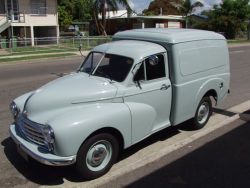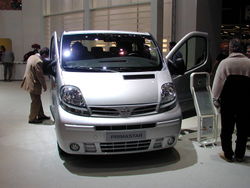Van
Car Show
Van
 Morris Minor van
Morris Minor van
 1978
CitroŽn 2CV AK400 van
1978
CitroŽn 2CV AK400 van
 A modern van, the
Nissan Primastar
A modern van, the
Nissan Primastar
A van is a vehicle used for
transporting
goods or groups of people. It is generally a rather box-shaped vehicle on four
wheels, about the same width and length as a large
automobile,
but taller and usually higher off the ground. It can either be a specially
designed vehicle or be based on a saloon/sedan car, the latter type often
including derivatives with open backs (pick-ups etc). Some vans can be really
small, like the van versions of the
Mini or can be really large like some Mercedes-Benz vans. Larger vehicles are classified as trucks or lorries.
Word usage and etymology
The word van is a shortened version of the word
caravan which originally meant a covered vehicle. In British English, this now
has a similar meaning to the U.S. terms travel trailer or
recreational vehicle (RV).
The word van has slightly different, but overlapping, meanings in
different forms of
English. While the word always applies to boxy cargo vans, the most major
differences in usage are found between the different English-speaking countries.
United Kingdom and Australia
British English speakers will generally refer to a passenger
minivan as a
people-carrier or MPV (multi-purpose vehicle), and a larger
passenger van as a
minibus.
British people, mostly older ones, will also sometimes call a
pickup
truck a van, something Americans would not do. Similarly, in
Australia,
panel vans,
RVs popular among young people in the
1970s, were based
on locally-manufactured
utes (short for utility, the local name for pickup).
United States
In the United States, a van can also refer to a box-shaped trailer or
semi-trailer used to carry goods. In this case there is a differentiation
between a dry van, used to carry most goods, and a refrigerated van (a reefer)
used for cold goods. A railway car used to carry baggage is also called a van.
Occasionally the term van is also used to refer to a minivan. However, minivans
are usually distinguished by their smaller size, unibody architecture, and
front wheel drive powertrains.
Examples
The standard or full size vans in the
United States were originally manufactured by the "big three": Dodge, Ford and
General Motors. The frame and drive train are identical or similar to the
full-sized pickups made by the each manufacturer but with a snub front,
resulting in most of the engine protruding under a console between the front
seats, often called a dog house. They have been sold as both cargo and passenger
models to the general public and as cutaway van chassis versions for second
stage manufacturers to make box vans, ambulances, campers and other vehicles.
Second stage manufacturers also modify the original manufacturer's body to
create custom vans for the general public. Dodge, now part of Daimler-Chrysler
quit making their model in June of 2002 and replaced it with the Dodge Sprinter which may be due to roll-over concerns.
Usage
In urban areas of the United States full-size vans have been used as
commuter vans since 1977, when Dodge introduced a van that could transport
up to 15 passengers. Commuter vans are used as an alternative to
carpooling
and other ride sharing arrangements.
Many mobile businesses use a van to carry almost their entire business to
various places where they work. For instance, there are those who come to homes
or places of business to perform services or to install or repair appliances.
Vans are also used to shuttle people and their luggage between
hotels and airports, to transport commuters between parking lots
and their places of work, and along established routes as minibuses.
Criticism
Recently, the passenger versions have been criticized for having a tendency
to roll over. The van body is taller than the cab and bed of the pickup that
uses the same style frame and powertrain resulting in the basic van having a
higher center of gravity than a similarly loaded pickup from which it is
derived. The seats in the passenger version raise the load, passengers, above
the floor, further increasing the center of gravity. The bench seats allow
passengers to slide if safety belts are not used (in the United States it is
common for only the front seat passengers to use their safety belts) and belted
passengers can still lean and shift a large amount. The result is a high center
of gravity and a shifting load, particularly in passenger versions. In addition,
many of the drivers of passenger vans drive them infrequently. Apart from safety
issues, it seems inefficient to have a high cross-sectional area and a high mass when only
transporting one to two persons on average. Average heights are for:
- Minivans 70.2 in
- Family sedans 57.3 in
- SUVs 70.7 in
This leads to increased energy demand and thus fuel consumption and more
consumption of other resources like steel, brake blocks, oil, etc.
Modular
vehicle concepts and
Low-energy vehicles are in preparation of avoiding those problems.
Alternatives
For business and private in most cases the usage of trailers gives the
possibility to transport bulky goods without the need to propel a heavy vehicles
all the time.
Utility cycling is a more extreme form of transporting goods. Here also
trailer are seen. Apart from bicycle couriers, window cleaners are employing
bicycles. For craftsmen in cities its also possible to use a transport service
i.e. the specialists may arrive via public transport and bulky or heavy material
is transported by courier services either from the same company or using courier
express or parcel services. Thus parking fees and city tolling may be avoided.
See also
Makes of van
Full-size vans
Chevrolet
Chevrolet Beauville
Chevrolet Corvair 95 Greenbriar
Chevrolet Express
Chevrolet G Series G10, G20, G30
Chevrolet Nomad Van
Chevrolet Sport Van
CitroŽn
CitroŽn Jumpy
CitroŽn Jumper/CitroŽn Relay
Dodge
Dodge A Series A100, A200, A300
Dodge B Series B100, B150, B200, B250, B350
Dodge Coachman
Dodge MB Series MB-250, MB-350
Dodge Sportsman
Dodge Sprinter
Dodge Tradesman
Dodge Ram Van
Fiat
Fiat Scudo
Fiat Ducato
Ford
Ford Econoline E-100, E150, E250, E350, E450
Ford Club Wagon
Ford Transit
GAZ
GMC
GMC Gypsy
GMC Rally Rally Wagon, Rally STX
GMC Savana
GMC Vandura 1500, 2500, 3500
Mazda
Mercedes-Benz
Mercedes-Benz Sprinter
Mercedes-Benz Vario
Mercedes-Benz V-Class
Nissan
Nissan Caravan
Nissan Elgrand
Nissan Interstar
Nissan Primastar
Nissan Silkroad
Nissan Vanette
Opel
Opel Movano
Opel Vivaro
Peugeot
Peugeot Boxer
Peugeot Expert
Plymouth
-
Plymouth PB Series PB-100, PB-200, PB-350
Renault
Renault Master
Renault Trafic
Toyota
Toyota Dyna
Toyota Hiace
Toyota Regius Ace
Toyota Toyoace
Volkswagen
Volkswagen Transporter
Volkswagen LT
Mid-size vans
Chevrolet
GMC
Minivans
British Leyland, United Kingdom
Bedford: Rascal, Midi
DaimlerChrysler: Dodge, United States
FSC, Poland
Iveco
LDV
Nissan, Japan
Saab automobile: Saab 95 (certain markets)
Holden: Combo
Alternative Propulsion
Since light truck are often operated in stop&go mode hybrid electric models
are useful:
The follwing vehicles may be used in yards or in historic city centres:
Home | Up | A-pillar | Bangle-butt | Brougham | Cab forward | Cabrio coach | Coupe | Crew cab | Dune buggy | Fastback | Hackney carriage | Hardtop | Hatchback | Hearse | High Wheeler | Kammback | Landau | Notchback | Panel van | Phaeton body | Retractable hardtop | Roadster | Runabout | Sedan | Shooting-brake | Softtop | Sportwagon | Spyder | Stanhope body | Station wagon | Cabriolet | Convertible | Leisure activity vehicle | Minivan | Pickup truck | T-bucket | T-top | Targa top | Three window coupe | Tonneau | Touring car | Van | Woodie
Car Show, made by MultiMedia | Free content and software
This guide is licensed under the GNU
Free Documentation License. It uses material from the Wikipedia.
|







